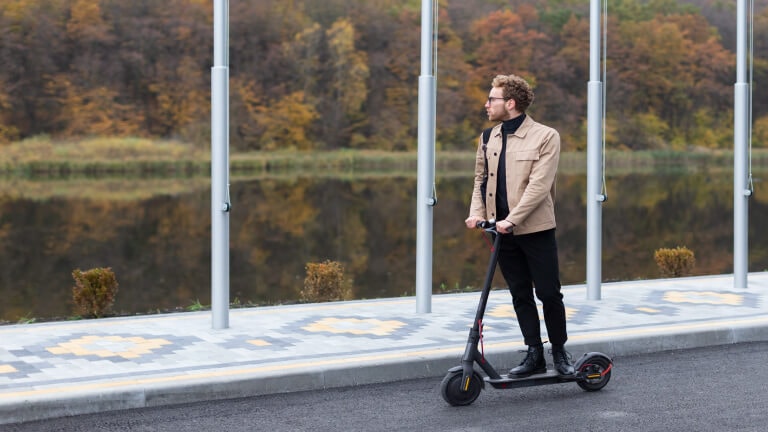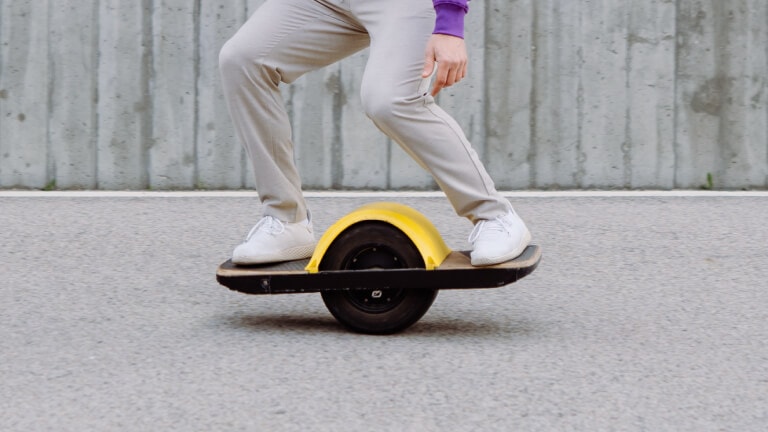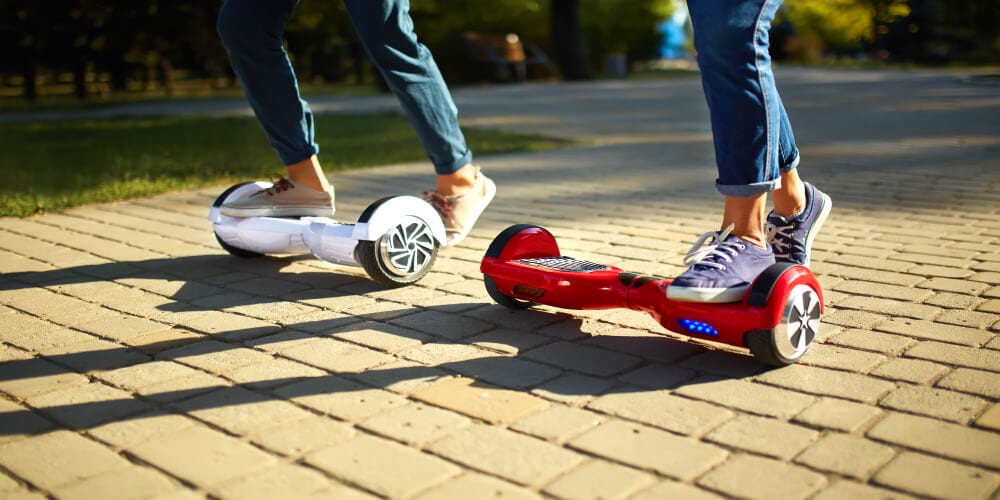Hoverboards have grown in popularity for all ages due to their design and technology. It has revolutionized personal transportation. It is a fun and futuristic way to glide through the streets.
When discussing hoverboards, it’s important to clarify that two distinct types come to mind. The first is the fictional hoverboard, popularized by the movie “Back to the Future Part II,” which floats in the air without any wheels touching the ground. This type of hoverboard, while fascinating and a subject of many scientific experiments, remains largely in the realm of science fiction.
The second type, and the one we’ll be focusing on in this guide, is the self-balancing scooter. Often referred to as a hoverboard, this wheeled electric personal transportation device allows riders to steer by shifting their bodies. Despite not hovering, these devices have captured the public’s imagination and have become a global sensation since they were first commercially available in 2013. They were inspired by those visions of futuristic transportation seen in films and literature and have brought a piece of that future into our present.
Let’s explore the fascinating world of hoverboarding together! This ultimate guide will empower you to glide confidently on hoverboards. It will also share different types and safety precautions and riding styles.
Evolution of Hoverboards
The technology behind self-balancing devices can be traced back to the invention of the Segway PT, created by inventor Dean Kamen and introduced in 2001. The Segway was the first widely recognized device to use self-balancing technology, although it featured handlebars for steering and control.

American businessman and inventor Shane Chen patented the first handlebar-less, self-balancing personal transporter — what most of us would recognize as a “hoverboard.” His company, Inventist, introduced the Hovertrax in 2013, often considered the first hoverboard.
While the basic technology behind hoverboards has mostly stayed the same since its introduction, there have been many refinements and improvements. Early models of hoverboards had safety issues, particularly concerning the risk of fires due to poor battery management systems. Improved battery technologies and safety standards (like the UL 2272 certification) have made modern hoverboards much safer.
Over the years, hoverboard technology has been refined for better performance. It includes improved motor efficiency, battery life, speed, and maneuverability. Modern hoverboards often come with Bluetooth speakers, LED lights, smartphone apps for performance tracking and adjustments, and integrated GPS. Some models now feature off-road capabilities, high speeds, and the ability to climb steep inclines.

Despite these advancements, the basic principle behind hoverboard technology — self-balancing achieved through gyroscopic sensors and control logic — remains the same.
How Hoverboards Work
Hoverboards operate on a self-balancing technology that relies on a combination of sensors, gyroscopes, and motors.
- Gyroscopic Sensors: The gyroscopes play a crucial role in maintaining balance by constantly measuring the tilt and orientation of the hoverboard. These sensors detect orientation changes, often using changes in rotational angles. When a rider leans forward or backward, the gyroscopes register this change and signal the control logic.
- Control Logic: This is the hoverboard’s “brain.” It receives data from the gyroscopes and sends commands to the motors. When a rider leans forward or backward, the sensors detect the sudden movement and send signals to the motors.
- Motors: Each wheel of a hoverboard has its independent motor. The control logic sends signals to these motors to either accelerate, decelerate, or change direction based on the input from the gyroscopic sensors and the pressure pads where the rider stands.
Through the seamless integration of these components, hoverboards provide riders with a smooth and intuitive riding experience. We’ll likely see even more impressive features and capabilities as technology advances.
Types of Hoverboards
As technology continues to evolve, so do these dynamic devices, now available in several distinct types. It includes hoverboards with handlebars or seats, one-wheeled models, and electric unicycles. Each category of hoverboards offers unique characteristics to suit a variety of users and terrains. Let’s explore some of the popular types:
1. Self-Balancing Scooters

Self-balancing scooters are hoverboards, but the term can encompass various devices that use gyroscopic technology to maintain balance. They typically feature two side-to-side wheels, a platform for the rider to stand on, and a motor powered by a rechargeable battery. Riders control the device by shifting their weight to dictate direction and speed. Examples include classic hoverboards and hoverboards with handlebars.
2. One-Wheel Hoverboards

One-wheel hoverboards, like the Onewheel board, are a hybrid between a hoverboard and an electric skateboard. They have a single, large wheel in the middle and a board extending on either side for the rider to stand on. These devices use self-balancing technology, allowing riders to control speed and direction by shifting their weight. They’re designed for all-terrain use and offer a unique riding experience like snowboarding. While they technically fall under the umbrella of self-balancing scooters, their design and functionality are distinct enough to separate them into their category.
3. Electric Unicycles

Electric unicycles are a specific type of self-balancing device, but they feature a single central wheel rather than the traditional two-wheel setup. The rider stands on platforms on either side of the wheel and controls the device by shifting their weight forward to move ahead, backward to reverse, and to the sides to turn. These devices often have a higher learning curve due to the increased balance requirement but offer greater agility and maneuverability once mastered.
4. All-Terrain Hoverboards

As the name implies, all-terrain hoverboards are designed to handle a variety of surfaces, from pavement and grass to gravel and dirt paths. They have more robust wheels and often feature a more powerful motor than the classic models.
All-terrain hoverboards stand out with their ability to navigate uneven surfaces and off-road conditions. They typically feature higher ground clearance and more robust suspension systems, offering a smoother ride on rough terrain.
How to Choose a Hoverboard
Choosing the perfect hoverboard can be challenging, given the variety of options available in the market. Here’s a detailed guide to help you make an informed decision:
Safety Standards
Ensure that the hoverboard is UL 2272 certified. This certification means that the hoverboard has passed numerous safety tests, including overcharge tests, short circuit tests, over-discharge tests, vibration tests, shock tests, crash tests, drop tests, mold stress tests, and water exposure tests.
Battery Life and Charge Time
Look for a hoverboard with good battery life, ranging from 1 to 3 hours of ride time on a single charge. Also, consider the charging time of the battery. A shorter charge time can be more convenient but often requires a more sophisticated (and expensive) charger.
Speed and Range
Check the maximum speed of the hoverboard. Most hoverboards offer a speed range of 6-10 mph, but some high-end models can go up to 12 mph or more. Another important consideration is the range or how far the hoverboard can go on a single charge. This usually depends on factors like the rider’s weight, the terrain, and the hoverboard’s battery capacity.
Wheel Size and Type
Hoverboards come in different wheel sizes, ranging from 6.5 to 10 inches. Larger wheels offer a smoother ride, especially on rough or uneven surfaces. Some hoverboards come with rugged, all-terrain wheels, ideal for off-road riding.
Hoverboard Weight and Weight Capacity
Consider the weight of the hoverboard, especially if you plan to carry it around. Most hoverboards weigh between 20-30 lbs.
Hoverboards come with different weight capacities. Make sure to choose one that can support your weight. Most standard hoverboards can support up to 220 lbs, but models are designed for heavier riders.
Additional Features
Look for additional features like LED lights for visibility, built-in Bluetooth speakers for music, or smartphone apps that offer functionalities like tracking your speed, battery life, and distance traveled.
Customer Reviews
Finally, checking customer reviews before buying a hoverboard is always a good idea. They can provide real-world information about the hoverboard’s performance and durability.
Whether you want a hoverboard for commuting, off-road riding, or just fun, there’s a model out there that’s perfect for you.
How to Ride a Hoverboard in 5 Easy Steps
Mastering the art of riding a hoverboard requires practice and proper technique. Follow these steps to ride a hoverboard confidently:
Step 1: Mounting the hoverboard
To mount the hoverboard, place it in front of you with the power button facing forward. Stand with one foot on either side of the hoverboard, ensuring your feet are positioned evenly. Keep your feet slightly wider than shoulder-width apart for better balance.
Step 2: Finding your balance
When you turn on the hoverboard, it will enter the self-balancing mode. Take a moment to get accustomed to the hoverboard’s balance by shifting your weight forward and backward. The hoverboard should respond by maintaining its level and not tilting excessively.
Step 3: Learning to move forward and backward
To move forward, gently lean your body weight forward, exerting pressure on your toes. The hoverboard will start moving in the direction you lean. Similarly, to move backward, lean backward and apply pressure on your heels.
Step 4: Mastering turns and pivots
To turn left, lean your right foot slightly forward; lean your left foot slightly forward to turn right—practice making smooth turns by gradually shifting your weight. For tighter turns, pivot on one foot while keeping the other stationery.
Step 5: Performing basic maneuvers
Once you have mastered the basics, you can experiment with additional maneuvers, such as spinning in place or riding in a zigzag pattern. Remember to start with small movements and gradually increase the difficulty level as you gain confidence.
Advanced riding techniques
As you become more proficient in riding a hoverboard, you can challenge yourself with advanced techniques. Riding on inclines and declines requires additional control and balance. Start with gentle slopes and gradually progress to steeper ones, always keeping your body aligned with the hoverboard.
Riding on rough terrain can be a thrilling experience but requires extra caution. Maintain a slower speed and be prepared for bumps and uneven surfaces. Flex your knees and ankles to absorb shocks and maintain stability.
Tips for a smooth and enjoyable ride
- Maintaining proper posture is crucial for a comfortable and safe ride. Keep your back straight, shoulders relaxed, and look forward while riding. Avoid leaning too far forward or backward, as it can affect your balance.
- Managing speed and acceleration is another essential aspect of hoverboard riding. Start slower until you feel confident, and gradually increase the speed as you become more comfortable. Remember to decelerate smoothly to avoid sudden stops or loss of control.
- Avoiding common mistakes can save you from potential accidents. One common mistake is looking down at your feet instead of focusing on the path ahead. Keep your gaze forward to maintain balance and anticipate any obstacles.
Maintenance and Troubleshooting
To keep your hoverboard in optimal condition and ensure a long lifespan, performing regular maintenance checks and promptly addressing any issues is essential. Here are some maintenance tips and troubleshooting guidelines:
Regular Maintenance Checks:
Hoverboards don’t require any special maintenance. Regular maintenance, including cleaning, tire pressure checks, and lubrication, is enough. Following the manufacturer’s guidelines and performing routine inspections will help keep the hoverboard in good condition.
- Inspect the hoverboard for any signs of damage or wear and tear.
- Clean the hoverboard regularly, removing dirt or debris from the wheels and body.
- Check the tire pressure and ensure it is within the recommended range.
- Lubricate any moving parts as per the manufacturer’s instructions.
- Keep the hoverboard dry and cool when not used.
Common Problems and Solutions
- If the hoverboard is unresponsive or not turning on, check the battery and ensure it is charged. If the battery is fully charged and the issue persists, consult the user manual or contact the manufacturer for further assistance.
- If the hoverboard is experiencing uneven balancing or drifting to one side, try recalibrating the gyroscope according to the manufacturer’s instructions.
- If the hoverboard makes unusual noises or vibrations, it may indicate a mechanical issue. In such cases, it is advisable to seek professional repair services.
Can hoverboards be used in rainy conditions?
Using hoverboards in rainy conditions is generally not recommended as they are not waterproof. Water can damage the electrical components and affect the performance and safety of the device.
Can hoverboards be used on uneven terrain?
Some hoverboards, specifically off-road models, are designed to handle uneven terrain. However, it is essential to check the specifications and capabilities of the hoverboard before attempting to ride on such surfaces.
Battery Care and Replacement:
- Follow the manufacturer’s hoverboard battery charging guidelines. Avoid overcharging or leaving the battery connected to the charger for extended periods.
- If the battery’s performance significantly decreases over time, consider replacing it with a new one. Consult the manufacturer or authorized service centers for battery replacement options.
How long does the battery of a hoverboard last?
The battery life of a hoverboard depends on several factors, including the model, terrain, and riding style. On average, most hoverboards can range 6 to 12 miles on a single charge.
Hoverboarding Laws in the US
Before you hop on your hoverboard and start cruising around, you must familiarize yourself with the legal considerations and regulations surrounding their use, especially in the United States. Here are some key points based on US law:
- In the United States, no federal laws specifically address the minimum age for hoverboard riders. However, individual states and local jurisdictions may have their regulations. For example, in California, riders must be at least 16 years old to operate a hoverboard legally.
- In most states, public roads and sidewalks Hoverboards are typically not allowed on public roads or sidewalks. They are considered personal transportation devices and may not be classified as street-legal vehicles. Riding on roads or sidewalks may result in fines or citations. Instead, look for designated areas such as bike lanes or parks where hoverboards are permitted.
- While not mandated by federal law, wearing safety gear is highly recommended for hoverboard riders. It’s advisable to wear a helmet, knee pads, elbow pads, and wrist guards to protect yourself in case of a fall or collision. Safety gear can significantly reduce the risk of injuries.
- Just like operating any other vehicle, riding a hoverboard while under the influence of drugs or alcohol is illegal and dangerous. It impairs judgment and coordination, increasing the risk of accidents. Always ride your hoverboard in a sober state.
- As a hoverboard rider, respecting pedestrians and yielding to them when necessary is essential. When riding in areas shared with bicycles or other vehicles, follow the traffic rules and regulations applicable to cyclists. Exercise caution and maintain a safe distance from pedestrians and other vehicles.
- If you plan to travel with your hoverboard, it’s important to check with the specific airline or transportation authority regarding their policies. Some airlines may restrict or prohibit hoverboards due to safety concerns related to lithium-ion batteries. Ensure compliance with any regulations to avoid any issues during your travels.
Remember, laws and regulations can vary between states and local jurisdictions, so you must check the specific rules in your area or any location you plan to ride in. Stay informed about any updates or changes to the regulations to ensure a legal and safe riding experience.
Future of Hoverboards
Hoverboard technology continues to evolve. It will not only be limited to recreational use. We may see hoverboards for commuting short distances, sports, and entertainment.
As the popularity of hoverboards grows, regulations and laws surrounding their usage may evolve. Riders must stay informed about changes in local regulations and adapt their riding habits accordingly. Moreover, the widespread adoption of hoverboards may have broader societal impacts, including changes in transportation infrastructure and environmental considerations.
Expect improvements in battery life, allowing for longer rides on a single charge. Speed capabilities may also increase, providing riders with faster travel options. Furthermore, advancements in self-balancing technology will enhance stability and control.
Conclusion
Hoverboards offer an exciting and unique way to navigate the urban landscape. We suggest choosing a hoverboard that suits your needs, prioritizes safety gear, and follows the recommended riding techniques. With practice and maintenance, you can enjoy hoverboard adventures.
